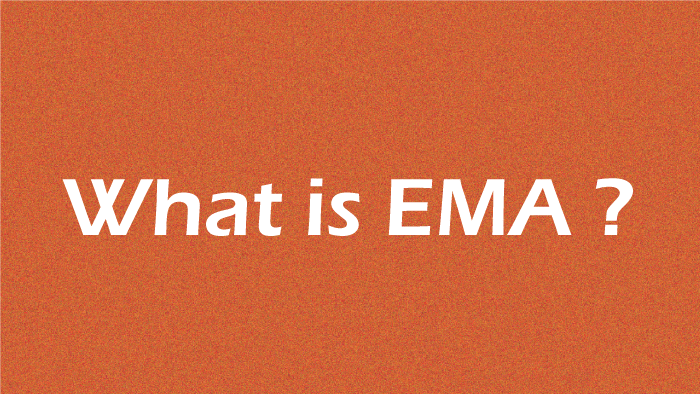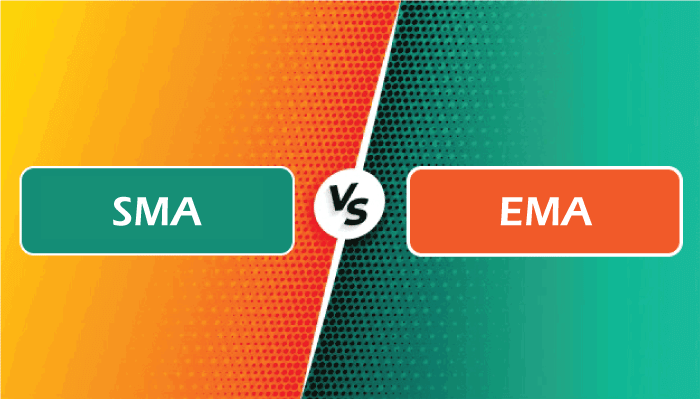What is EMA? How to Use Exponential Moving Average With FormulaAn exponential moving average (EMA) is a technical chart indicator that tracks price movements in financial assets (like stocks, securities, or shares) over time, where it places more weight on recent data points, such as the latest prices, in contrast to simple moving averages (SMA), causing it to react faster to price change. 
All moving averages have the same fundamental goal: to identify patterns/trends in a financial instrument based on past price points; thus, they are also known as lagging indicators. Moving averages can only say whether there have been shifts in the stock's trends/directions; they don't forecast any price movement in the future. To help them identify trends, direction, and strength, day traders include this indicator in their charts, and others use it to determine entry and exit points. Calculation of EMATo overcome some of the shortcomings of the SMA, the EMA was created. The computation of EMA involves three steps. These consist of the following: The first step is calculating the SMA for the first EMA, which is a relatively simple procedure. Because an EMA must begin someplace, a simple moving average is employed as the EMA from the prior period in the first computation. For instance, to determine the SMA for the past 30 days, add the values of the previous 30 closing prices and divide by 30. Let's say a stock's closing price during the past 10 days was 1, 2, 3, 4, 5, 6, 7, 8, 9, and 10. So, the simple average is 1+2+3+4+5+6+7+8+9+10/ 10, which equals 5.5. Here, the divisor 10 represents the number of days. A "moving average" is adjusted as new data is received. The second step is to compute the weighting multiplier for the number of periods to compute for the EMA. Utilise the formula below to determine the weighting multiplier. EMA[current] = ((Price[current] - EMA [previous day]) x Multiplier) + EMA[previous day] Remember that the weighting multiplier is constantly significantly influenced by the number of periods. The below formula can be employed to compute the EMA once the values for the SMA and weighting multiplier have been established: EMA = (Closing price - EMA[previous]) x multiplier + EMA[previous] Difference between SMA and EMA
SMA and EMA are both used to measure trends and employ the same principles to smooth price changes in a trade, which is one of many similarities between the two indicators. However, there are also some distinctions between the two indicators. Unlike SMA, which cannot react quickly enough to rapid price variations, EMA can respond more quickly to changes in price points due to the calculating process. The EMA is utilised for shorter periods and rapidly moving markets, but the SMA is employed when a trader holds a position (long or short) for an extended length of time. These computations are also utilised to detect market trends by filtering out noise caused by random price changes. EMAs can depict a rapid change in market sentiment, while SMAs cannot. The EMA weights current data from a trading session more significantly, whereas the SMA determines the average price data from the entire period. Another distinction is that the EMA is somewhat more price-sensitive than the SMA. Compared to the SMA, the high sensitivity of EMA enables traders to see trends more quickly. EMA differs from SMA in that the EMA calculation for a given day depends on the EMA computations for all previous days. To compute a relatively accurate 10-day EMA, it needs considerably more than 10 days of data. Advantages of EMASince the EMA is an indicator that provides an estimate of the rise or fall of a financial instrument, it has several advantages. They are:
Limitations of EMAAlthough EMA offers the benefits mentioned above, it also has some drawbacks or limitations. They are:
Next TopicWrit of Attachment
|
 For Videos Join Our Youtube Channel: Join Now
For Videos Join Our Youtube Channel: Join Now
Feedback
- Send your Feedback to [email protected]
Help Others, Please Share









